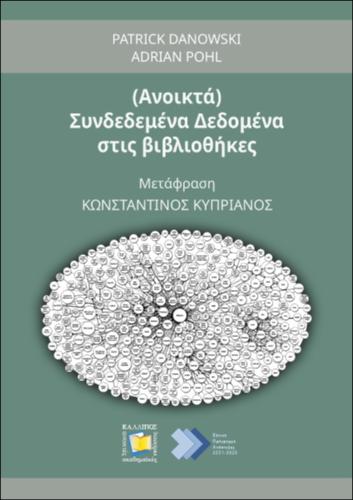| Title Details: | |
|
(Open) Linked Data in Libraries |
|
| Authors: |
Danowski, Patrick Pohl, Adrian Kyprianos, Konstantinos (Tr.) |
| Subject: | MATHEMATICS AND COMPUTER SCIENCE > COMPUTER SCIENCE > COMPUTATIONAL SCIENCE > DATA, INFORMATION AND KNOWLEDGE MATHEMATICS AND COMPUTER SCIENCE > COMPUTER SCIENCE > INFORMATION MANAGEMENT MATHEMATICS AND COMPUTER SCIENCE > COMPUTER SCIENCE > INFORMATION MANAGEMENT > INFORMATION STORAGE AND RETRIEVAL LAW AND SOCIAL SCIENCES > ECONOMIC SCIENCES > BUSINESS ADMINISTRATION AND BUSINESS ECONOMICS; MARKETING; ACCOUNTING > LIBRARY SCIENCE AND ARCHIVING |
| Keywords: |
Cataloging
Resource description and access Standards for bibliographic description Library catalogs Cataloging rules Information resources Semantic web Linked data Open data |
| Description: | |
| Abstract: |
This work is an attempt to describe the state of implementation of the new technologies of the Semantic Web and Open Linked Data in the library sector. It is an important handbook since it is the first approach to present the relationship of Open Linked Data with libraries and knowledge organizations in general. It is written in simple language and can provide a good basis for those interested in gaining general knowledge about these technologies.In the beginning, basic information and concepts about open-linked data are given so that the reader can understand these technologies on a theoretical level, followed by concrete examples of applications in German libraries and organizations. In this way, the reader gains the theoretical background necessary to understand these technologies and learns how they are applied in knowledge organizations. More specifically, the first chapter deals with the basic concepts and historical developments of linked data and open data, with a focus on the library community. This is followed by an explanation of the technical characteristics of linked data, and then the legal framework for open licensing (access) is described. The second chapter attempts to provide an overview of the vocabulary currently available for describing bibliographic data as linked data and comparing them without going into excessive detail. The next chapter deals with the representation of journal publications using FRBRoo, thus solving problems that have been created by the lack of proper documentation and presentation of these collections. While the fourth chapter deals with another important issue concerning the provenance of linked data - a parameter that is very important regarding linked data. Chapter five discusses the research data. More specifically, open-linked data offers an infrastructure for uniformly describing research data, identifying it clearly, and making it available to as many users as possible. Within this context, the challenges, opportunities, and benefits of a LOD-based infrastructure for describing and linking research data are presented based on the experience gained in the InFoLiS project. Chapter six introduces the theoretical aspects that are important about catalog enrichment based on (open) linked data and gives an example of how to enrich bibliographic data based on other LOD sources via the LOD lobid.org service. In chapter seven, various projects and technologies are presented and their potential contributions to the German Digital Library are further elaborated. Chapter eight presents the challenges and the process followed to create B3Kat in 2011 as Open Data in MARC/XML format and as Linked Open Data in RDF/XML format which is the joint catalog of the Bavarian Library Association (BVB) and the Berlin-Brandenburg Cooperative Library Association (KOBV). Chapter nine presents the development of an information system for the use of linked data in the field of archaeology. Finally, the text concludes with appendices on the definition, terminology, and requirements of open knowledge. The principles for open bibliographic data and recommendations for opening up bibliographic data are also mentioned. This is followed by a glossary that includes all the terminology that has been used throughout the work.
|
| Linguistic Editors: |
Kioseoglou, Nerina |
| Graphic Editors: |
Koundouros, George |
| Type: |
Undergraduate textbook |
| Creation Date: | 20-09-2022 |
| Item Details: | |
| ISBN |
978-618-5667-47-4 |
| License: |
Attribution - NonCommercial - ShareAlike 4.0 International (CC BY-NC-SA 4.0) |
| DOI | http://dx.doi.org/10.57713/kallipos-83 |
| Handle | http://hdl.handle.net/11419/8571 |
| Bibliographic Reference: | Danowski, P., Pohl, A., & Kyprianos, K. (Tr.). (2022). (Open) Linked Data in Libraries [Undergraduate textbook]. Kallipos, Open Academic Editions. https://dx.doi.org/10.57713/kallipos-83 |
| Language: |
Greek |
| Consists of: |
1. Open linked data in the library community: Fundamentals and overview 2. Vocabularies for bibliographic data 3. FRBR, journals, and CIDOC CRM - Modelling journals using FRBRoo 4. The provenance of linked data 5. Research data 6. LOD-based data enrichment 7. The challenge of knowledge linking: Impulse plans for a future LOD concept of the German Digital Library 8. Open linked data comes to the surface: B3Kat releases its data 9. Open data and linked data in an information system for archaeology 10. Annex 1 - Open knowledge Definition: Open knowledge 11. Annex 2 - Open Knowledge Principles of open bibliographic data 12. Appendix 3 - Recommendations for opening library data 13. Glossary |
| Number of pages |
222 |
| Publication Origin: |
Kallipos, Open Academic Editions |
| You can also view | |
| User comments | |
There are no published comments available! | |

